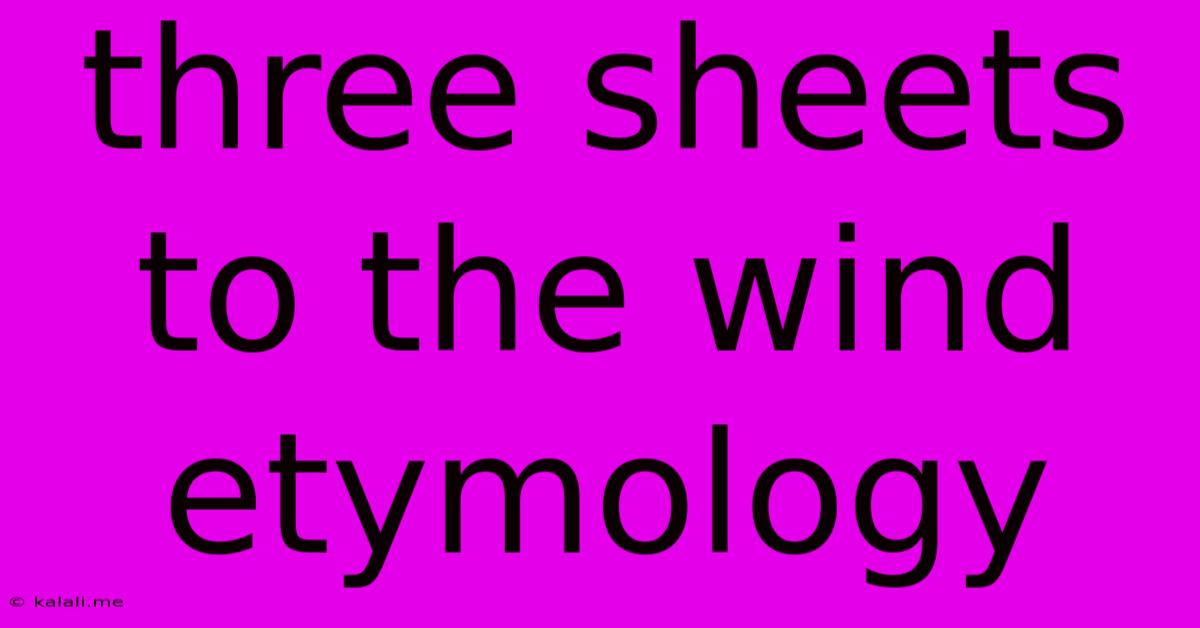Three Sheets To The Wind Etymology
Kalali
May 22, 2025 · 3 min read

Table of Contents
Three Sheets to the Wind: Unraveling the Nautical Origins of a Common Idiom
The phrase "three sheets to the wind" is a colorful idiom used to describe someone who is significantly intoxicated. But where did this nautical term originate, and what does it actually mean? This article delves into the etymology of this common phrase, exploring its historical context and linguistic evolution. Understanding its roots reveals a fascinating glimpse into the language of sailing and the colorful metaphors used by sailors.
Understanding the Metaphor: Sheets and Sails
Before understanding the idiom, we need to grasp the nautical terminology. On a sailing ship, "sheets" are the ropes used to control the sails. Specifically, they control the angle of the sails in relation to the wind. A ship with its sheets properly managed is sailing efficiently and under control. Conversely, a ship with its sheets loose or "to the wind" is uncontrolled and potentially dangerous.
The Evolution of "Three Sheets"
The number "three" in the idiom likely isn't literal. It's a way of emphasizing the extent of the disorder. Instead of saying "one sheet to the wind," implying slight disarray, "three sheets to the wind" magnifies the level of disorganization, representing a ship completely out of control, tossed about by the wind. This metaphorical extension emphasizes the extreme state of inebriation described by the phrase. The "wind" itself refers to both the literal wind impacting the ship's sails, and, metaphorically, the intoxicating effect of alcohol on the individual.
Early Appearances and Usage
While pinpointing the precise origin is difficult, the earliest known recorded use of "three sheets to the wind" dates back to the late 18th century. Its usage quickly spread, cementing its place in nautical and colloquial English. It's plausible that the phrase developed organically within the sailor community, passing through oral tradition before making its way into written records.
From Sailors to Everyday Speech:
Over time, the phrase transitioned from the specialized vocabulary of sailors to broader everyday use. Its vivid imagery and clear meaning made it readily adopted by the general population, even by those unfamiliar with sailing. The persistence of this phrase highlights the enduring power of colorful metaphors and nautical imagery in shaping our language.
Similar Idioms and Their Significance:
The idiom "three sheets to the wind" shares a family resemblance to other nautical metaphors used to describe drunkenness, such as "high as a kite" or "drunk as a lord." These linguistic parallels reflect the historical connection between sailors, seafaring life, and the widespread use of alcohol. Each idiom evokes a distinct image, contributing to the rich tapestry of idiomatic expressions in the English language.
Conclusion:
The idiom "three sheets to the wind" offers a compelling example of how nautical terminology has enriched everyday language. Its origins in the practical realities of sailing provide a concrete image for understanding the chaotic state of extreme intoxication. The evolution of this phrase reflects the enduring influence of seafaring culture and the power of vivid metaphors in communicating complex ideas. Its continued use underscores its effectiveness and the enduring fascination with the imagery it evokes.
Latest Posts
Latest Posts
-
Is The Niv A Catholic Bible
May 23, 2025
-
Dnd Reckless Attack And Extra Attack
May 23, 2025
-
Fallout 4 How To Run A Wire
May 23, 2025
-
Use Rope To Reinforce Bunk Bed Frame
May 23, 2025
-
Do Not Meddle In The Affairs Of Dragons
May 23, 2025
Related Post
Thank you for visiting our website which covers about Three Sheets To The Wind Etymology . We hope the information provided has been useful to you. Feel free to contact us if you have any questions or need further assistance. See you next time and don't miss to bookmark.